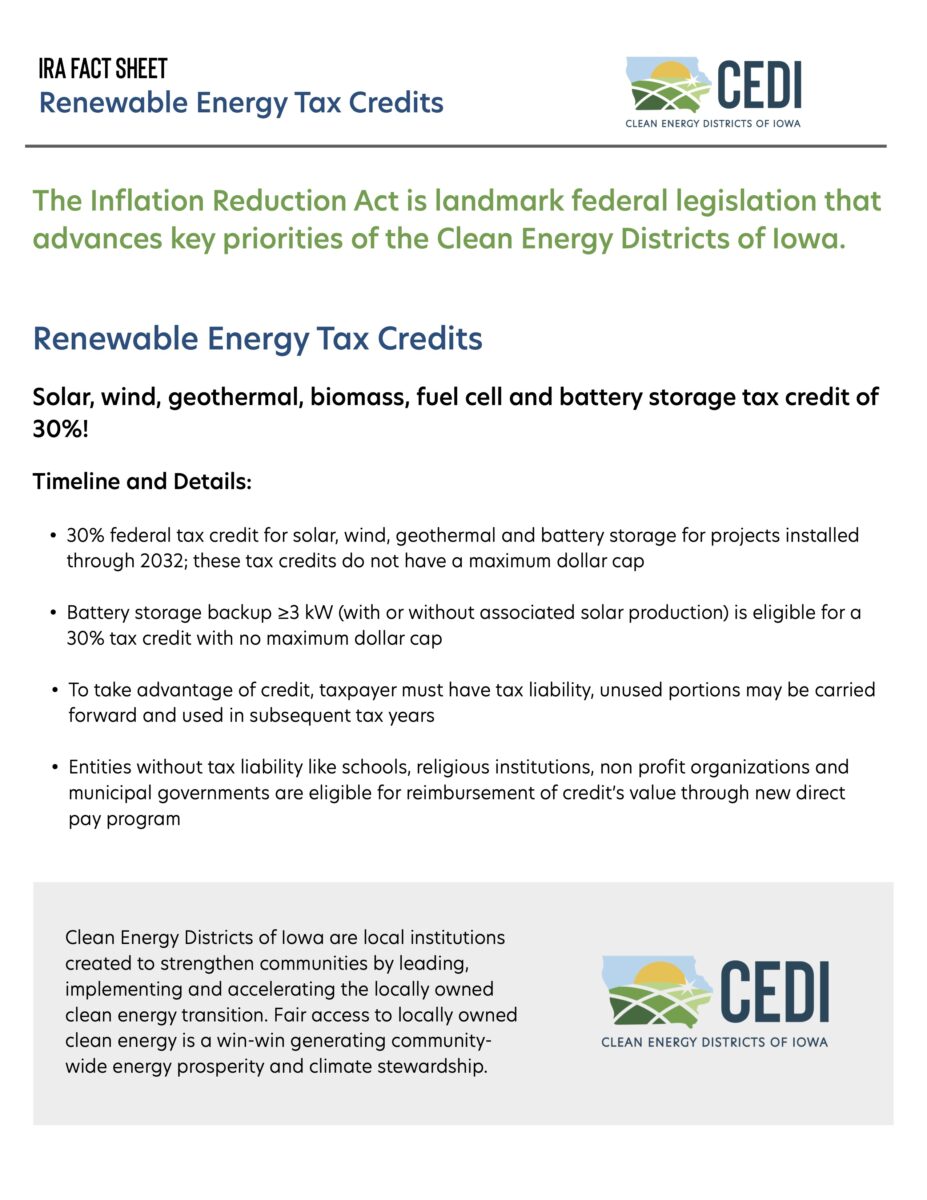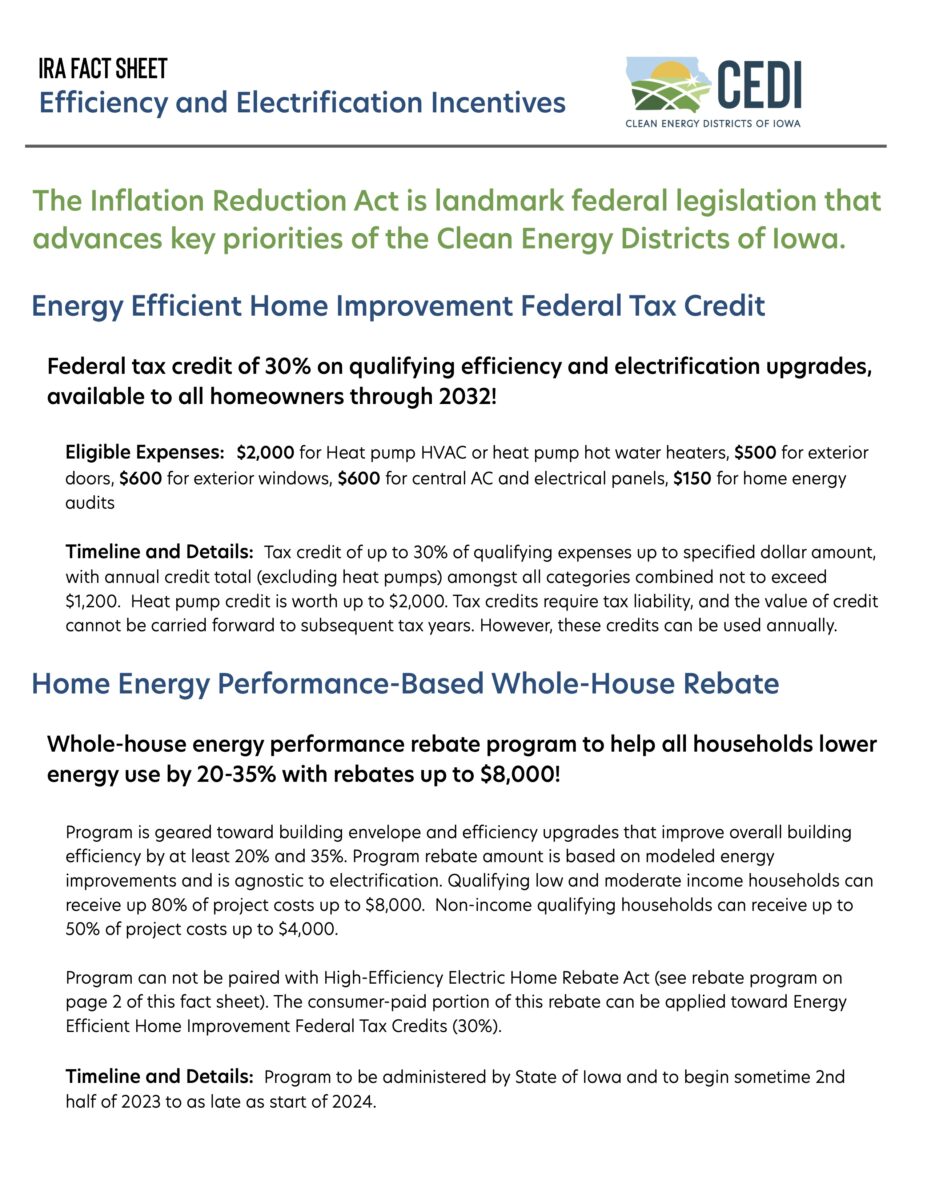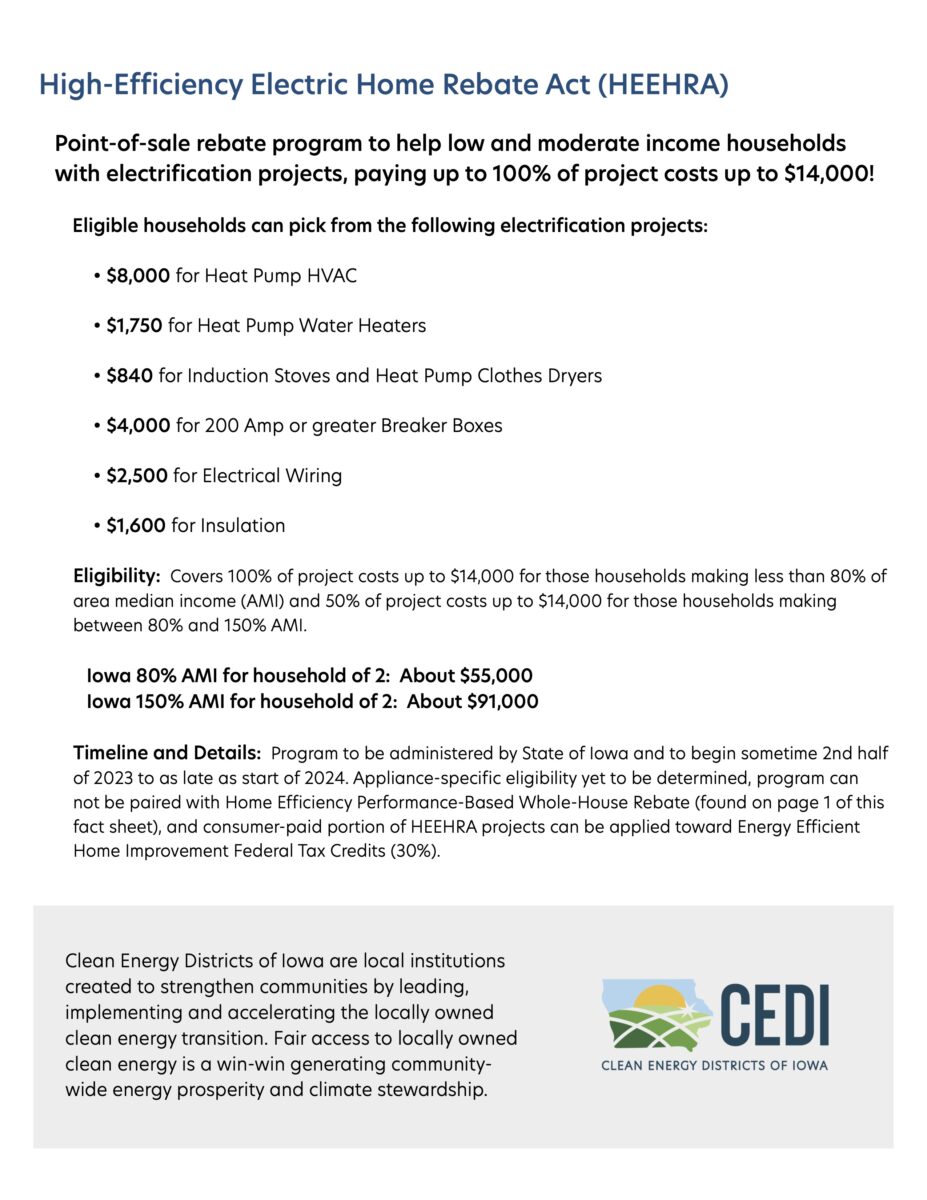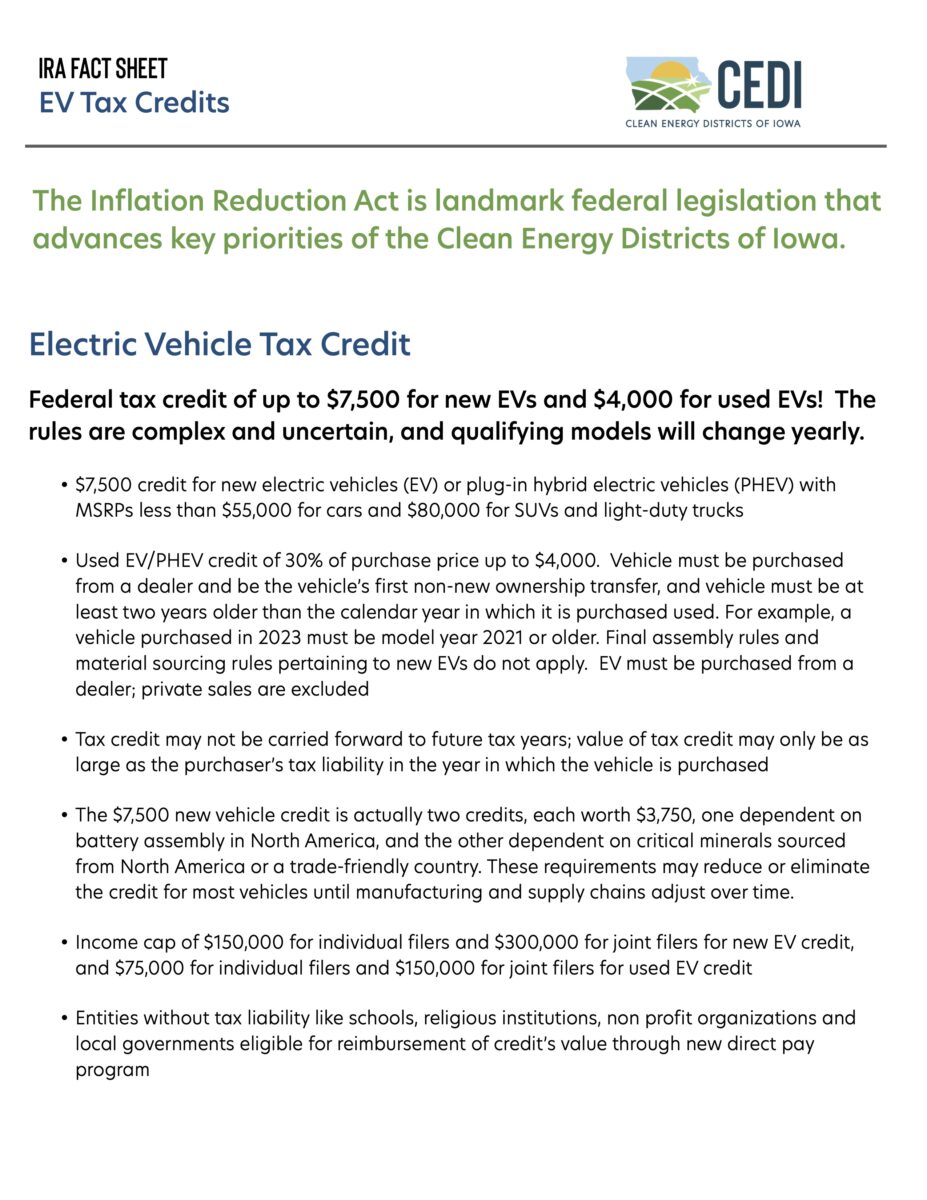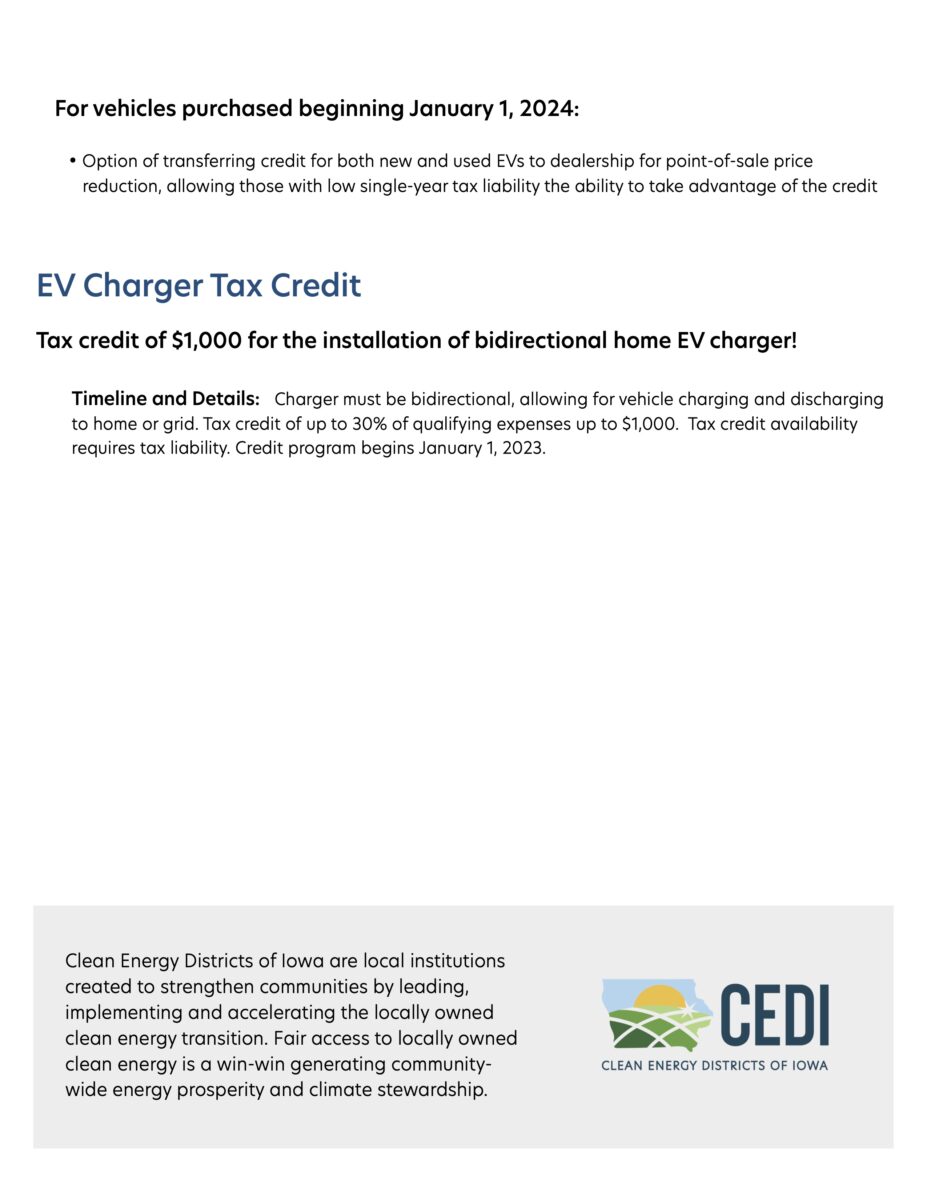The IRA: A New Year, New Incentives (Including IRA Program Fact Sheets)
Paul Cutting, Energy Planner
The first of many new IRA-related tax credits and incentives came into effect January 1, 2023, and include new and updated tax credits for solar, battery storage, heat pumps, electric vehicles and more. We’re also excited about two electrification and efficiency rebate programs, and anticipate they will come into effect sometime late this year or early 2024.
Solar, Battery Backup, Wind and Geothermal Tax Credits
Following the signing of the IRA last August the tax credit for residential solar increased to 30% and remains in effect for the next ten years. Iowa’s state solar credit is gone, but with total install costs as low as they are, the typical Alliant homeowner will see a payback period for solar as short as 7 1/2 years. Since MiEnergy’s rates are lower than Alliant’s, the “value” of solar and the resulting payback period for MiEnergy customers is a bit longer. If you’ve been holding off on solar, now might be time to move forward.
The law also extends the battery storage tax credit, and decouples battery systems from having to be installed with solar. Now a standalone battery backup system 3 kW and larger is eligible for the 30% tax credit.
In addition to solar and battery backup, tax credits for geothermal, biomass, wind and fuel cell systems have been extended until 2032 at 30%. For these credits there is no maximum tax credit dollar cap, the credit is nonrefundable (meaning the value of the credit can only be as large as your tax liability), and the value of the credit can be taken over multiple tax years.
Tax Credits for Heat Pumps, Electric Panel Upgrades, Insulation, Exterior Doors and Windows, and Energy Audits
Homeowners are eligible for a 30% tax credit up to $2,000 for the purchase of heat pumps used for space and water heating. The credit can be taken annually (without a lifetime cap, meaning one can do a project one year and another the next), but the value of the credit is only as large as one’s tax liability during that specific year. The value of the credit can not be carried forward to subsequent tax years. Over the past few months I’ve written about ducted and ductless heat pumps. Since the value of the heat pump credit is relatively modest (at 30% up to $2,000), and that it can be taken annually, perhaps now’s the time to start thinking about what a phased-in electrification of your home’s heating looks like.
New tax credits of 30% up to $600 are available for electrical panel upgrades 200 amps and greater, insulation of 30% up to $600, exterior windows of 30% up to $600, exterior doors of $30% up to $500 (up to $250 per exterior door) and energy audits and assessments of 30% up to $150. Excluding heat pumps, the total value of the efficiency credits for all other categories combined can not exceed $1,200 annually, meaning the maximum value of the credits combined for a single year is $3,200.
The New-New Electric Vehicle Tax Credit
Here’s where things get really complicated. Beginning January 1, 2023 electric cars and sedans with MSRPs under $55,000 and SUVs with MSRPs under $80,000 might be eligible for a $7,500 tax credit for those individual tax filers with incomes below $150,000 and for joint filers whose incomes are below $300,000. The credit can be used toward plug-in hybrids whose batteries are greater than 7 kW as well as any fully electric model. Complete IRS guidance can be found here.
The EV tax credit is nonrefundable and can not carry forward to subsequent tax years, meaning that in order to take full advantage of the credit, one must have sufficient tax liability the year the vehicle was purchased.
The $7,500 new vehicle credit is actually two credits, each worth $3,750. One is dependent on battery assembly in North America, and the other is dependent on critical minerals sourced from North America or a trade-friendly country. Rules around battery assembly and critical materials go into effect in March and may reduce or eliminate the credit for many vehicles until manufacturing and supply chains adjust over time. If you are at all inclined to move forward with the purchase of an electric vehicle, we suggest you do so before these new rules go into effect. And according to information from Consumer Reports, “purchase” means having the vehicle in-hand, and not just a signed purchase agreement with money down.
The Used Electric Vehicle Tax Credit
In addition to the new EV credit, the IRA also establishes a used EV tax credit worth up to $4,000. Like the credit for new vehicles, it is nonrefundable and can only be used during the tax year in which the vehicle was purchased. The credit equals 30% of the purchase price of the vehicle up to a maximum of $4,000. To be eligible, the used vehicle must have a sale price under $25,000, must be the first sale of the vehicle (after its initial purchase), and single filers must have an adjusted gross income of less than $75,000 or $150,000 for joint filers. The vehicle must be at minimum two years older than the calendar year in which the used vehicle is purchased. For example, a vehicle bought this year has to be a model year 2021 or older. And the vehicle must be purchased from a dealership; private vehicle sales are excluded.
The Rebate Programs
Beginning sometime during the second half of 2023 to as late as the start of 2024, two new rebate programs to encourage home electrification and measured residential energy efficiency will come into effect. The law sets aside roughly $4.5 billion for each program. The money is to be distributed to each state and each state is tasked with implementation. Iowa’s total allocation for both of the two rebate programs is $121.3 million, meaning that if each household received $10,000 in assistance, only about 12,000 Iowa households would be served. In other words, the rebate programs probably won’t last long. If you’re inclined to take advantage of either, we recommend you start planning now by talking to contractors about upgrade options, or coordinating with us to receive an energy assessment to identify areas of opportunity.
The High-Efficiency Electric Home Rebate Act (HEEHRA) provides homeowners making less than 80% of area median income (or about $55,000 for a household of two) up to 100% of project costs up to $14,000 to be used for heat pumps for space and water heating, heat pump clothes dryers, induction stoves, breaker box upgrades, electrical wiring and insulation. Those with incomes between 80-150% of area median income (or about $55,000 to $91,000) will be eligible for rebates worth up to 50% of project cost up to $14,000. Any qualifying consumer-paid portion of of the rebate program (specifically projects for heat pumps, electrical panel upgrades, and insulation) can be applied against the 30% efficiency tax credits, meaning the savings can, in theory, be greater than the rebate program thresholds.
The Home Efficiency Performance-Based Whole-House Rebate (HOMES Act) is a whole-home efficiency rebate program that provides rebates of up to $8,000 for improvements that lower energy use by 20-35%. Unlike HEEHRA’s focus on electrification, the HOMES Act is electrification-agnostic, meaning projects that lower overall energy use by certain thresholds are eligible for the rebate. For example, an eligible project might be upgrading an old, inefficient forced air gas furnace with a high efficiency model, just so long as the upgrade lowers overall energy use by either 20% or 35%.
There are so many unknowns regarding the two rebate programs. For example, to what degree will they be point of sale versus reimbursement, are they retroactive in any way, what are the standards around appliance qualification, etc, etc, etc? If possible, we suggest you start thinking about potential projects, but wait to go ahead until the programs are in place. We’re determined to make sure these dollars get directed to families in Northeast Iowa, and when we know more about the specifics of these new rebate programs, we’ll make sure to spread the word far and wide.
IRA Fact Sheets:
